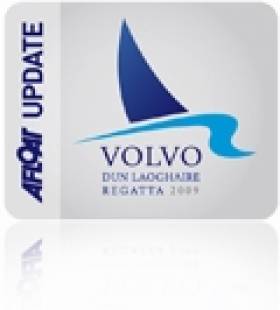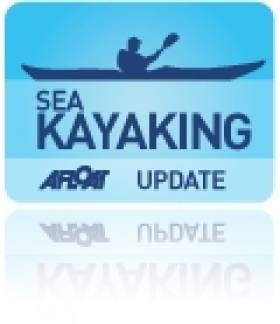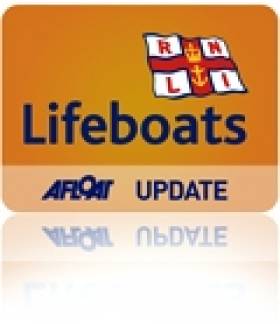Displaying items by tag: Holyhead
Raging Bull Top Again in First ISORA Race
A 'tough opener' is how Commodore Peter Ryan has described the first ISORA offshore sailing race of the season from Holyhead to Dun Laoghaire yesterday. Inspite of the difficult conditions though there was little change at the top of the leader board. Skerries domination of Irish Sea racing continues with the Sigma 400 Raging Bull maintaining his winning form. It was a very hard race with usual flukey conditions trying to leave Dublin Bay at 8am on Saturday morning (Afloat.ie followed the fleet out of the bay on twitter). Strong winds followed for the beat to the M2 buoy before another long leg and a short beat to Holyhead. The sea conditions on the 60-mile course were trying for many crew who were out for the first time this season.
ISORA has formed three classes this season, the aim is to give better competitive sailing between similar boats. First race results below.
| Boat Name | Sail No. | Type | IRC Rating | Finish Time | Time elapsed | Corrected | Place | Place |
| (provisional) | Time | Class | O/A | |||||
| English Mick | GBR4771R | Beneteau 47.7 | 1.130 | 19:18:26 | 40706 | 45997 | 2 | 8 |
| GFT Adventurer | GBR23161 | Beneteau 45 | 1.101 | 19:54:46 | 42886 | 47217 | 3 | 9 |
| Quite Correct | IRL 5405 | DS54 | 1.095 | RET | - | - | - | - |
| African Challenge | IRL 2649 | Fast 42 | 1.077 | RET | - | - | - | - |
| Tsunami | IRL 4007 | First 40.7 | 1.061 | 18:48:01 | 38881 | 41252 | 1 | 4 |
| Lancastrian | GBR 7682T | Starlight 14.5m | 1.059 | 20:27:00 | 44820 | 47464 | 4 | 10 |
| Rebellion | IRL 6001 | Nicholson 58 | 1.054 | RET | - | - | - | - |
| Orna | IRL 532 | 1.047 | DNS | - | - | - | - | |
| Madam Wen | GBR1417L | Sweden 42 | 1.04 | RET | - | - | - | - |
| Aztec 3 | IRL29832 | A35 | 1.034 | 18:59:30 | 39570 | 40915 | 3 | 3 |
| Raging Bull | IRL 9666 | Sigma 400 | 1.027 | 18:42:30 | 38550 | 39590 | 1 | 1 |
| Jedi | IRL 8088 | J109 | 1.029 | RET | - | - | - | - |
| Sgrech | GBR9319R | J109 | 1.026 | 19:01:52 | 39712 | 40744 | 2 | 2 |
| Miss Scarlett | IRL 4763 | Sunfast 40.3 | 1.025 | RET | - | - | - | - |
| Lula Belle | IRL 3607 | First 36.7 | 1.019 | 19:35:55 | 41755 | 42548 | 5 | 6 |
| First of September | IRL 8581 | First 43.5 | 1.017 | DNS | - | - | - | - |
| Dinah | IRL 3508 | JOD 35 | 1.016 | 19:36:22 | 41782 | 42450 | 4 | 5 |
| Adelie | FRA 9631 | First 34.7 | 0.988 | 21:26:00 | 48360 | 47779 | 2 | 11 |
| Mojito | GBR 4184 | Bravaria 39 | 0.988 | 20:36:22 | 45382 | 44837 | 1 | 7 |
| Mistral of St Helier | K 8337 | Sigma 38 | 0.984 | RET | - | - | - | - |
| Yahtzee | IRL 1068 | Oceanis 411 | 0.983 | 02:23:00 | 66180 | 65054 | 3 | 12 |
| Obsession | IRL 4513 | Sigma 33 | 0.905 | RET | - | - | - | - |
| Sarnia | IRL 2260 | 0.891 | RET | - | - | - | - |
Ulysses Celebrates 10 Years of Irish Sea Service
In January 2000 the keel of the worlds largest car ferry was laid at the Aker Finnyards in Rauma, Finland. The following year the €100m cruiseferry giant departed the shipyard on a four-day delivery voyage to Dublin Port. Upon Ulysses's arrival on 4th March she was presented with a traditional welcoming escort of saluting water-firing tugs.
The Ulysses was named at a ceremony in the port on 21st March by the 'golden godmother' Mairead Berry, Ireland's 25-year old Paralympic Games gold medallist. Four days later Ulysses made her commercial maiden voyage to Holyhead on 25th March.
Wih 12 decks the vessel has an extensive range of facilities and they are named with themes derived from James Joyce's famous novel 'Ulysses'. There is seating available for up to 1,938 passengers and there are 117 twin or single-cabins, accommodating up to 228 passengers.
Only two months into service the Ulysses won the prestigious 'Most Significant New Build - Ferry' category award in the Cruise & Ferry magazine 2001 Awards competition. Her Finnish builders are not only builders of large cruise-ferries for Baltic Sea operators and beyond but also are also renowned for the construction of very large cruiseships for international clients.
Ulysses was designed specifically to serve the central corridor route with a schedule of two round trips daily. She directly replaced the 1997 Dutch built 34,031 grt ro-pax Isle of Inishmore, which transferred to Rosslare-Pembroke Dock service.
In 2006 the Ulysses alongside her fleetmates were transferred from the Irish flag to the Cypriot flag in addition to a change of Irish crew with those outsourced from citizens mostly from the Baltic and Eastern European countries.
Due to the sheer size of the Ulysses, which has a length of 209m, a beam of nearly 32m and a 6.4m draught, she has not missed a single crossing due to bad weather conditions. The vessel has a 22 knot / 41kph service -speed on the 60-mile route which translates to a distance of over 182,000 kms a year.
To celebrate Ulysses 10th year in service, Irish Ferries has enhanced the Club Class option to passengers which includes free-Wifi, which enables a constant connection and an array of other benefits during the 3-hour 15 minute crossing.
For a virtual tour of the Ulysses with views taken from the top deck as the cruiseferry departs Holyhead and the mountains of Snowdonia setting as a backdrop plus interior tours of the vessel click here.
HSS Fast-Craft to Return on Dun Laoghaire Route
According to Stena Line over 70% of its passengers business is carried by the HSS Stena Explorer in the high season. It is felt that the 1996 Finnish built fast-craft is better suited for the service due to a loyal customer base which was reflected by repeat bookings and their preference of the HSS craft on the 120 minute (2 hour) route.
A daily single round trip is scheduled with sailings from Dun Laoghaire to Holyhead departing at 13:15hrs. The corresponding sailing from the Anglesey port departs at 10.00hrs and arrives at the Irish port at 12 noon. Sailings will operate through the summer until 13 September.
From there on Stena will make a decision as to its continuing schedule, though it is widely believed that the prospects of the fuel-thirsty, expensive to run HSS fast-craft service are likely to be at an end of an era.
Last month negotiations over the core issue of harbour fees were held between Stena Line and Dun Laoghaire Harbour Company. It is understood that the annual fee of €6.5m was dropped to €2m. The board of the harbour company has given a 'conditional green light' of a new ferry contract to Stena Line to run the service for the next two years with an option of a third year.
The service closed for its seasonal break earlier this year on 5 January with the 'Lynx' going into temporary lay-up at Holyhead's inner harbour to join the HSS Stena Explorer. The HSS had been 'wintering' at the port since September sailings were taken over by the Lynx.
Earlier this month the Stena Lynx III came to Dun Laoghaire to continue her lay-up period. The 1996 Tasmanian built craft will stay there before resuming seasonal sailings between Rosslare-Fishguard in tandem with the conventional ferry Stena Europe.
In the meantime the craft is berthed at the harbour's two-berth ferry terminal at St. Michaels Wharf. The HSS berth is only designed for this type of fast-craft whereas the other berth now occupied by the Lynx was built originally for conventional ferries but was re-configured last year to suit the fast-craft.
Entries Roll in for Volvo Dun Laoghaire Regatta
Forty entries are already in for Volvo Dun Laoghaire Regatta, a fixture widely expected to be the biggest in Ireland this season when it sets sail on Dublin Bay in July.
Organisers are expecting up to 500 boats to keep it on a par with the 2009 event. The early entries, 11 weeks ahead of the entry deadline, is being taken as a thumbs up by competitors for the fun and vlaue theme of this year's VDLR.
So far 22 different clubs have entered from six countries. The bulk of the fleet is Irish but there are early entries from France, Isle of Man, UK, Wales and Northern Ireland. Another good turnout is exepcted from Liverpool and Holyhead for boats competing in the IRC Lyver Cup Race across the Irish Sea. Ten boats from the Clyde will also compete on the Bay.
Cork's Conor Phelan the skipper of Jump Juice is one of the first Royal Cork boats confirmed.
Two handed IRC racing makes its debut in July's Volvo Dun Laoghaire Regatta organisers have also confirmed. Click HERE.
On the dinghy front, the Fireball class has confirmed it will be running an'Open Championship' within the regatta, an event that follows the class world championships in Sligo in June.
Ferry-Go-Round on the Irish Sea
In the case of Irish Ferries, their Rosslare-Pembroke Dock route vessel, Isle of Inishmore arrived on the Mersey yesterday at the Cammell Laird dry-dock facility in Birkenhead.
The 1997 Dutch-built Isle of Inishmore had relieved the 50,938 tonnes 'flagship' Ulysses from the Dublin-Holyhead route which too had gone to Birkenhead for maintenance since January 4th.
The Ulysses is now back on service and the company's French routes cruiseferry, Oscar Wilde is covering the Isle of Inishmore's absence from Rosslare-Pembroke Dock sailings.
Continental services to France on the Rosslare-Cherbourg route will resume on February 16th when the Oscar Wilde returns from her overall. The Bahamas flagged vessel will re-open seasonal Rosslare-Roscoff sailings starting on May 13th.
In addition to conventional tonnage Irish Ferries also operate the fast-craft catamaran Jonathan Swift in tandem with Ulysses on the Dublin-Holyhead route. The Ulysses takes 3 hours 25 minutes while the 39-knot catamaran craft marketed as the Dublin 'Swift' is advertised with a scheduled passage time of 1 hour and 49 minutes.
The Australian-built catamaran was taken off the central corridor route yesterday to be drydocked also in Birkenhead until January 18th. Dublin Swift sailings return to the Dublin-Holyhead route on February 19th with the first crossing to depart at 14.30 hours from the capital port.
For the latest information on ferry sailings and reservations click: www.irishferries.com
Search Resumes After Missing Kayak Located
Early this morning a red Avocet kayak answering the description of the one used by missing female kayaker, Elizabeth Ashbee, a member of Shrewsbury Kayak Club, was found on the beach at Morfa Nefyn on the Lleyn peninsular. There is no apparent damage to the craft. It has now been confirmed that the craft was the one being used by Ms Ashbee.
The North Wales Police were informed who have now inspected the vessel and the maritime search and rescue operation has now resumed. The family of the missing woman has been informed.
Holyhead RNLI all weather lifeboat was asked to resume its search, and two helicopters from the RAF at Valley together with a North Wales Police helicopter are conducting a shoreline search in Caernarfon Bay, particularly from Lleyn to Morfa Nefyn, Fort Belan and Llanddwyn.
Coastguard Rescue Teams from Aberdaron, Porth Dinllaen and Llandwrog are also engaged in searching the coastline in the Bay.
Holyhead Coastguard have been broadcasting pan signals into area alerting shipping to the resumed search.
The weather on scene is a slight sea, with good visibility and south westerly winds of between 10 – 12 knots.
Ms Ashbee, wearing a dry suit and a buoyancy aid went missing Sunday afternoon in her kayak in poor weather and was last seen heading through rocks at Ynys Feurig, or Starvation Island, close to Rhosneigr. An area of up to 60 square miles has now been covered in the search.
Members of the Shrewsbury Kayak Club have also arrived on scene and are assisting Coastguard units in the search.
Sheep Rescued by RNLI
A lifeboat crew rescued a sheep and a seal pup in two separate incidents off Anglesey on the far side of the Irish Sea last week.
Moelfre RNLI lifeboat crew helped the sheep after it fell 20ft from cliffs onto an isolated island and became marooned for up to two days near Bull Bay. The full report from the Holyhead Mail is HERE.
Related Safety posts
RNLI Lifeboats in Ireland
Safety News
Rescue News from RNLI Lifeboats in Ireland
Coast Guard News from Ireland
Water Safety News from Ireland
Marine Casualty Investigation Board News
Marine Warnings

































































